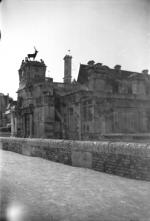|
Benetfink Lightning N° 1 |
Manufactured or assembled in United Kingdom from (Circa) 1898 to (Circa) 1902.
Index of rarity in France: Infrequent (among non-specialized garage sales)
Inventory number: 14151
See the complete technical specifications
Chronology of cameras Benetfink
 In 1816, on the steps of St. Benet Fink Church in London, a little abandoned boy was found and named Samuel Alexander Benetfink, likely named after the church's patron saint and the individuals who discovered him. His early years were marked by sadness and hardship. In 1844, at the age of 28, after apprenticing in the hardware industry, he ventured into business by founding Benetfink & Jones.
In 1816, on the steps of St. Benet Fink Church in London, a little abandoned boy was found and named Samuel Alexander Benetfink, likely named after the church's patron saint and the individuals who discovered him. His early years were marked by sadness and hardship. In 1844, at the age of 28, after apprenticing in the hardware industry, he ventured into business by founding Benetfink & Jones.
The name changed to Benetfink & Co in 1852, then to Benetfink & Fox in 1862, and finally back to Benetfink & Co in 1867. The company would retain this name when it was acquired in 1907 by AW Gamage.
By 1860, Benetfink had gained international recognition in the field of hardware in the broadest sense (tableware, lighting, magic lanterns, bicycles, cameras, etc.), offering both low-cost and luxury products (silverware, ivory, etc.). Benetfink also acted as a distributor for various products, typically under the manufacturer's brand, such as Houghton and Lancaster in the field of photography.
Benetfink produced two types of cameras: luxurious bellows cameras (made of mahogany and genuine leather) and detective cameras.
Years |
Plates |
Plan-film | Features |
||
| View camera | |||||
Ajax Camera |
 |
1898- ? |
Yes |
Mahogany and leather Two models according to format (half or quarter plate) |
|
Waverley |
 |
1898- ? |
Yes | Similar to Ajax (half or quarter plate) Rack and pinion focusing, reversible back, lens and shutter sold separately. |
|
Picwick camera |
 |
1898 - ? |
Yes |
Mahogany and leather Tilt, double extension, ground glass focusing with reversible back, simple shutters (I, T) or elaborate (Thornton Pickard). |
|
| Detective type cameras | |||||
Speedy hand camera |
 |
1895- ? |
Yes |
Yes | Frame counter, guillotine shutter, close-up lens attachments. |
N° 1 Lightning Hand camera |
 |
1898-1902 ? |
12 |
24 | Frame counter, dual viewfinders, iris diaphragm, shutter speeds from 1/5 to 1/100, supplied with close-up lenses for photography from 9 feet onwards. Exposed views can be removed without risk to unexposed ones. Two different sizes. |
N° 2 Focussing Lightning Hand camera |
 |
1898-1902 ? |
12 |
24 | Identical to No. 1 but with bellows and rack-and-pinion focusing, rotating iris diaphragm, no close-up lens attachments. |
| N° 3 Lightning Hand camera |  |
1898-1902 ? | Yes |
Special model for cyclists, compact and portable, similar to the Lightning No. 2. |
|
N°3 Twin Lens Lightning Hand camera |
 |
C. 1901 |
Yes | ||
Flash Hand camera Model 1 |
 |
1900 - ? |
12 |
Frame counter, dual viewfinders, achromatic lens with rotating iris diaphragm, I and T shutter with speed regulator. |
|
Flash Hand camera Model 2 |
1900 - ? |
12 |
Similar to Model 1, but with three close-up lens attachments. |
||
Flash Hand camera Model 3 |
1900 - ? |
12 |
Similar to Model 2 with an improved lens. |
||
The detective cameras manufactured by Benetfink share several common features:
They can hold 12 glass plates or 24 sheet film exposures.
Film advance is activated by a slide mechanism on the top of the camera, which includes a frame counter.
The plates have hooks at the bottom, which slide on a metal plate that holds and guides them. This metal plate is bent and moves with the plates when they are dropped. Exposed plates can be removed through a door on the bottom of the camera without affecting unexposed plates.
The plates are pushed by a double curved frame, providing gentle tension.
They feature two mirror viewfinders for composing images.
If applicable, the apertures are on a rotating disc with notched openings.
This information and images are either publicly available or provided with the permission of historiccamera.com, to which we extend our thanks. __________
A white badge located on the top identifies this camera as the Benetfink Lightning.
Many elements are similar to those of the Lightning No. 2; however, the apertures are adjusted with an iris diaphragm, and the focus is unique, as a sliding ruler with three hoods (3, 6, and 9 feet) is placed in front of the lens.

Interesting links or bibliography :
Add a link or element of bibliography, a picture taken with this camera, a picture of box or an ads about this camera
Your photos taken with the same camera:
Cameras from Ebay France (Benetfink) (Uploaded each 3 hours)







